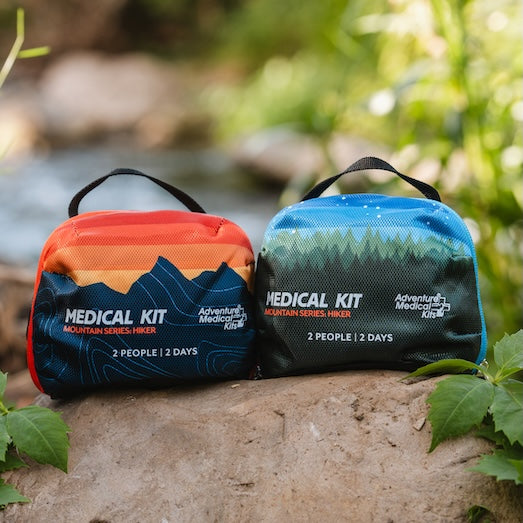You’re lost. Alone in the woods. The backpacking trip was going so well until you decided to explore beyond the trails, and now you’re down to your last Clif Bar.
Some would lose hope, but not you! For you’ve just learned all about entomophagy – the fancy word used to describe eating insects. To a knowledgeable forager, the forest is basically a buffet – teeming with nutritious, delicious bugs.
But First – Why Eat Bugs?!

PC: Dani Murray
In short, insects are nutritious, sustainable, and can taste great.
For the purpose of this article, I will use bug and insect interchangeably, though bug can be a broader umbrella term used to refer to both insects and land-arthropods in general (including arachnids like scorpions and spiders.)
Although lesser known to Western menus, bugs are part of the regular diets of roughly 2 billion people across the globe. For a comparable amount of protein, insects like crickets have more calcium, iron, B12, zinc, Vitamin A, and other micronutrients than beef. A gram of most insects gives you more protein than a gram of beef. Insects contain complete proteins—with the right balance of essential and non-essential amino acids—providing a better source of protein with a lower carbon footprint. Choose any food-enviro-metric you like: gallons of water, CO2 equivalents of greenhouse gases, acres of land, feed-conversion-ratio comparisons, you name it. Insects will come out ahead.

PC: @bugible
Eating bugs is not a flashy new health trend, but has been practiced for thousands of years all over the globe. While you might be considering eating bugs as a last resort when lost in the wild, our ancestors ate bugs because they were delicious sources of nutrition. They did so out of desire. Both Native Americans and colonists enjoyed fried cicadas, grasshopper flour, and bug fruitcakes. According to the UN’s Food and Agriculture Organization (FAO), humans have been eating bugs for thousands of years, especially in tropical climates where insects grow larger, there are more of them, and harvests are more predictable. Bugs remain a protein-rich food staple for billions of people today.
The Original Hunter Gatherers Ate Bugs – Will You?
Both women and men could hunt or gather bugs for their nutritional properties – protein, healthy fats, and a host of micro-nutrients. Native Americans roasted June Beetles over coals and ate them like popcorn. They also ate cicadas, sometimes called the “shrimp of the land.” Often cooked up in garlic or salt, cicadas taste like seafood, popcorn, or bacon. Native American tribes were also said to dig large trenches, cover them with straw, and then drive hordes of crickets into the traps to later eat. Aboriginal Australian tribes traditionally dug Witchetty Grubs from the roots of acacia trees. The taste could be compared to a fatty tuna, at once meaty and melty.

PC: Dani Murray
The ancient Romans and Greeks dined on bugs. The first-century Roman scholar Pliny wrote that Roman aristocrats enjoyed eating beetle larvae raised on flour and wine. Aristotle described in his writings the best time to harvest cicadas, “The larva of the cicada on attaining full size in the ground becomes a nymph; then it tastes best, before the husk is broken. At first the males are better to eat, but after copulation the females, which are then full of white eggs.”
Even the Bible mentions eating bugs. The Old Testament describes the consumption of locusts, beetles, and grasshoppers for Christians and Jews. St. John the Baptist allegedly survived on locusts and honey when he lived in the desert.
OK, OK – Bugs Are Edible… But Which Ones Should We Eat?
With over 2,000 species of edible insects already identified, we have a whole world to explore.
Insect flavors range all over the map—scorpions and waterbugs are a bit fishy, sago grubs taste like bacon, and crickets have an umami, nutty flavor. In Oaxaca, grasshoppers are roasted with garlic, dusted with chili powder, and sprinkled with lime. In China, black ants are used medicinally and are said to boost libido. Slugs are edible and highly nutritious. They have occasionally been known to host a dangerous parasite called the rat lungworm and must thus be cooked before eaten to be safe.

PC: Dani Murray
The insects that are increasingly available for sale in the U.S. are all farm raised specifically for human consumption. They are held to the same health standards as any other food product.
Before running off to pop the nearest bug into your mouth, there are a few things to consider: not all insects are edible, and some contain parasites or toxins that can be harmful to humans. Most of this can be avoided by choosing to consume farm raised insects, as discussed above, or by cooking the insect. In the wild, a general rule of thumb is to avoid eating brightly colored insects or insects covered in fuzz. More often than not, vibrant colors are signals to predators to avoid ingesting toxic insects.
Another note: insects are arthropods, or the same group a seafood crustaceans like shrimp or lobster. As such, those allergic to shrimp or other shellfish may be allergic to some insects.
When push comes to shove, however, it is totally possible to consume most insects raw. Insects are safer than eating many traditional meats like cow, chicken, and pig because they are more genetically removed from humans and we run a lesser risk of catching food-borne illness from them.
It is not encouraged for the average consumer to eat bugs from the wild, as it’s important to make sure the bugs are feeding on substances that are non-toxic and pathogen-free. While eating wild bugs is best left to the experienced foragers, we’re going to cover the basics today. Hopefully you’ll be inspired to dig a little deeper and consider insects as a great addition to your next adventure – lost or not!
Let’s Go Bug Hunting
Now that we’ve covered some of the bug-basics, let’s get back to the situation at hand: you’re lost in the woods. You’re hungry. And you’re ready to hunt some bugs.
Wild Crickets
Inhabiting grasslands, fields, open meadows, and many of our backyards, crickets have a long tradition as foraged human food, as well. Insects like crickets are wonderful sources of non-meat proteins in the wild. Collecting wild crickets normally brings up two issues: first, you need to find enough of them. Second, you need to get past being grossed out and actually eat them. (Hopefully by this point, the latter is a non-issue).

@bugible
A simple trap for crickets can be set with nothing more than a Mason jar and some bait. Dig a small hole in the ground of a zone with many crickets, put the jar into the hole, and move the soil back into place around it. Put a piece of bait in the jar – a slice or apple, carrot, lettuce, oats, etc – and check back in the morning. Some crickets should be found snacking on the little treat.
Before consuming, wash the crickets. My preferred euthanasia method is freezing crickets. Then, I like to boil or roast my crickets, depending on the type of meal I’m creating.
Wild Mealworms
The mealworm (Tenebrio molitor) and the superworm (Zophobas morio) are consumed as larval forms before they become beetles. Mealworms are traditionally consumed canned or live, or can be baked into breads and cookies, deep fried with potatoes for more nutritious french fries, or simply roasted with salt for a protein-rich snack.
Nutritional data on mealworms varies hugely depending on the breed, conditions they are raised in, and the feed they subsist off of. Some sources suggest that mealworms are 12.72% fat (the good kind), 20.27% protein and 1.73% fiber.
The protein from insects is highly bioavailable. Briefly: proteins are made up of amino acids. The human body needs 22 amino acids to optimally function. While the body can produce most amino acids, there are 9—the “essential amino acids”—that need to be consumed from our food. Many plant sources need to be eaten in combinations—like beans and rice—to allow the body to manufacture all of the amino acids. Critters like mealworms make an excellent addition to any diet, especially when more traditional forms of protein are unavailable.
Contrary to what their name suggests, mealworms are not traditional worms, but rather the larvae of the darkling beetle. They are light brown and darken as they age. They can grow to as long as 1.25 inches when full grown and are food-motivated, subsisting in any environment that will provide them with a reliable food source. When foraging for wild mealworms, we must examine dark, moist places such as beneath rocks or rotten logs or in animal burrows. They will eat decaying leaves, dried grasses, or grains.

PC: @bugible
At the end of the day, mealworms are not picky. Foragers looking to collect wild mealworms will have success checking areas where excess biological waste has accumulated. The activity of collecting wild mealworms will more closely resemble the gathering end of the hunter-gatherer totem pole. It is critical to ensure that the substrate that foragers collect their mealworms from is relatively clean in a sense. Mealworms obtained from places rich in bacteria, pesticides, sewage, or excrement should be avoided. Even those obtained from grain stores should be properly cleaned and cooked before eating.
If you have the time, you should conduct what is referred to as “purging the bug” before cooking. Purging harvested bugs involves leaving them to rest for several days without food to eliminate any waste in the bugs’ systems before cooking. So if you’re in a survival situation and planning (and you have that Clif bar), you could ration the food you have to last while you wait for the bugs to purge. After, the protein-packed critters can be boiled, roasted, or fried depending on the type of meal.
As discussed earlier, make sure to harvest your mealworms from an area less likely to be contaminated by highly industrialized areas or bacteria-prone environments.
Wild Scorpions
Do you expect to be trapped in a desert any time soon? If so, brushing up on your dry landscape survival skills will be necessary. In dry, desert environments, it is essential to know where to find adequate supplies of protein. Thankfully, if we lift up a few stones we might be lucky enough to find some scorpions.
People often ask, “Is it safe to eat a scorpion? I heard they were venomous.” They do have a stinger on the tail. Hence, after a scorpion is caught, the tip of the tail with the venom sack can be cut off. Then they are best put out of their misery with a knife to the head. The poison in a stinger is a protein, which can cause allergic or other adverse reactions occasionally. (A quick note about scorpion venom: researchers are currently investigating therapeutic uses for the venom ranging from potential Lupus and Rheumatoid Arthritis treatments to efficacy on sclerosis and cancer.)
Heat denatures proteins, rendering the venom safe. Ergo it is always wise to cook scorpions before eating them. The same applies to eggs. When you cook eggs, they transform from runny globs to solid clumps. They change composition. As a general rule, it is always best to cook bugs before eating them. Insects, arachnids, and other critters can contain parasites or worms that are best avoided.

PC: @bugible
But still – scorpions? People tend to be visually discerning when they’re looking at food. The most common scorpion that’s sold in pet stores—the Emperor scorpion—is rather large and black. The physical appearance alone can be challenging for most.
But how do they taste? Good. Rather, great! They are not far off from shrimps, lobsters, or crabs. One can visualize how they might be part of a similar family of creatures. In fact, scorpions are jokingly referred to as “little land lobsters” in entomophagy communities.
Scorpions might be one of the easier foods to catch in the desert. If you are really “roughing it” and without a stove, you can roast the scorpion on a stick or place it on a hot coal or stone to cook.
Roasting a scorpion over a fire is a lot like roasting a marshmallow. Go slow, turn it, and make sure not to get it too close to the flames, or the legs could burn off. When it is thoroughly toasted, the base of the legs change color on some species and a little juice is excreted.
The whole scorpion can be eaten. Much like crabs, the claws are some of the best parts and full of meat from the muscle. The other thing to remember about scorpions is that since they live in the desert, they might often go long stretches without eating – months, even. They are very slow digesters, so it is not that unusual that when you’re eating their body, you’re now eating what they consumed a month ago – like crickets, flies, other scorpions, or even lizards. They can also eat small animals such as mice. While they can survive months without food, scorpions must have water to drink.
The most common scorpions are found in southern Arizona, central Texas, and central Oklahoma. Other known species of scorpions can be found as far northwest Mexico to south of Colorado, Mississippi, Kansas and in southern Missouri. Some are even found in Florida and west to Oregon and California.
Wild Shield Bugs
How would you feel if I told you that stink bugs are one of my favorite snacks? I quickly learned that it’s better to introduce these edible creatures by one of their other common names – shield bugs or chust bugs. Whatever you call them, they’re edible.
Shield bugs are characterized by well-developed hardened extensions of the thorax over the abdomen (the scutellums). These can be triangular or semi-elliptical in shape. Members of the Pentatomoidia superfamily usually have antennae with five segments. They have piercing mouth parts that are used to suck sap from plants, though some use these to eat other insects. In large numbers, these bugs can become significant pests. Shield bugs have glands in their thoraces between their first and second pair of legs that excrete an unpleasant-smelling liquid used to deter potential predators.
Shield bugs can be found in many regions all over the world. One continent’s nuisance is another’s nutrition. Several species of shield bug can be found on encino trees in Central Mexico. In parts of rural Zimbabwe and South Africa, shield bugs are shaken out of trees and eaten as a delicacy. Shield bugs are found all over the globe. Generally, they can be easily collected in the winter when they seek shelter in homes or under leaves in the woods.
Wild Sago Grubs
Sago grubs are the larva of the palm weevil (Rhynchophorus ferrugineus)—one of the two species of snout beetle known as the red palm weevil, Asian palm weevil, or sago palm weevil. Adult beetles are relatively large (2-4 cm long) and rusty red in color. Sago grubs excavate holes in palm tree trunks up to a meter long, weakening and eventually killing the host plant. Not surprisingly, sago grubs are considered a major pest.
Originally from tropical Asia, these bugs have been reported in places like Africa, the Mediterranean, Spain, Malta, Italy, Portugal, Morocco, Tunisia, and the Americas.
Sago grubs are yellow-white in color, segmented, legless, and have a chitinous head that is a darker brown than the rest of the body. Their horizontal jaws are conical and quite powerful, as they are used to burrow through their host plants.
The best place to collect sago grubs in is sago palms. They feed on the starchy pith of decaying palm trees. Infested trees will have yellowing and wilting palms. Tree cross loss or leaf wilt are typically only visible long after the palm has become infested—usually six months or longer. In highly dense infestations, the sounds of larvae burrowing and chewing can be heard when placing your ear to the trunk of the palm.
To search for sago grubs, you can chop a palm trunk and assess the spongy internal of the tree. Those hoping to “farm’’ sago grubs sometimes deliberately cut openings on fallen palms to attract adult females to lay eggs inside. In about six weeks, the larvae will be plump enough to harvest; if left much longer, they may go into cocoons.
Once harvested, sago grubs should be kept in the shade with pieces of damp wood. They can survive for a few days like this, but will die more quickly under direct sunlight or in dry environments.
Sago grubs are typically “clean” bugs to eat, as they only feed on and live inside palm tree pith. They are considered delicacies in Southeast Asian countries. These high-nutrient meals are frequently eaten alive, toasted, or steamed. They have been described as creamy tasting when raw, and like bacon when cooked. Very different tastes, but both good.
It is common to eat live sago grub. If you desire to give the live grubs a taste, hold the chitinous head with two fingers and avoid getting bitten. Squeeze the head to kill it first and take a bite from the back. The first bite of a raw sago grub might leave you with more of a “Lion King” experience than you bargained for, as it will burst in your mouth. You have to be prepared for a bite of bug guts. The skin is tough and chewy.
One thing to remember: You don’t eat the head. You pick a sago grub up by its head and then, holding the head, put it into your mouth. The flavor might surprise you; the taste of raw sago grub has been described as coconut milk with a bit of sweetness.
If chomping on squirming sago grubs is too savage for you, no problem. The grubs can be fried, boiled, grilled, and more—it’s easy to cook these critters. One of my favorite recipes involves steaming the larvae wrapped in sago palm leaves. Cooked this way, they taste a bit like oysters or snails with a little hint of that bland vegetable taste. Most of the taste associated with sago grubs actually comes from the cooking method.

PC: @bugible
Perhaps the simplest way is to stir-fry them in a pan until they are completely dry and crispy. First, wash and rinse the grubs. Next, cut an opening in the grubs so that they won’t burst while being cooked. You might notice yellow stuff ooze out of the grubs—that’s the fat. Sago grubs are packed with oil. Finally, simply pour the grubs into a pan and stir fry them slowly. Salt, veggies, or other seasoning can be added for flavor. Other common ways to prepare sago grubs include roasting them on a spit.
Sago grubs are not only valued for their nutritious content. Their oils are very suitable for pharmaceutical use. The grubs also make great animal feed or fish bait. The high dietary fiber found in the grubs makes them useful in aiding digestion. The sago grubs also offer economic opportunities to farmers in developing parts of the world as a main source of income generation.
Sago grubs go by many names: sago worm, coconut worm, palm tree worm, palm grubs, palmetto grub, palm tree weevil, edible maggot, Asian palm weevil, grugru, grew-grew or sago palm weevil. Whatever you call them, you should also call them food. Populations in areas where food security is a major problem have made use of these super-foods for centuries, and it is time that the rest of us embraced alternative proteins like sago grubs as versatile ingredients.
Congrats – You Can Now Survive the Woods
If you’ve read this far – congrats! You can now survive your misguided off-roading backpacking trip. Maybe eatings those bugs in the woods has opened your eyes to this sustainable, attainable, and—if cooked properly—delectable, food source for meals at home as well. If that’s the case, you can learn more at eatbugsevents.com. At the very least, retain the information about the existence of this very achievable protein source in the case that you’re ever in a bind for food.














